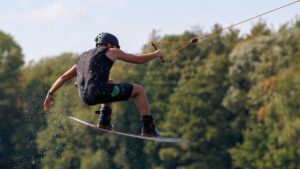A kneeboard is a watersport accessory that supports someone’s body while they are being towed behind a speedboat. Generally, kneeboards come in two different sizes.
The bottom of the board is designed to accommodate the knees and hands during use. Do Knee Boards Come in Different Sizes? There are two standard sizes for knee boards.
One size can accommodate children and adults who weigh about 150 lbs or less. The second size can accommodate adults who weigh more than 150 lbs.
A child who is older, taller and weighs more than 150 lbs may not be able to fit on a smaller kneeboard Use of a Knee Board Kneeboards are typically used for wakeboarding, waterskiing and other watersports, such as tubing.
A kneeboard is a watersport accessory that supports someone’s body while they are being towed behind a speedboat.
Generally, kneeboards come in two different sizes. The bottom of the board is designed to accommodate the knees and hands during use.
A kneeboard is a watersport accessory that supports someone’s body while they are being towed behind a speedboat.
Generally, kneeboards come in two different sizes. The bottom of the board is designed to accommodate the knees and hands during use.
A smaller board is usually best for children who are under 150 pounds and taller than 4 feet 11 inches, although it can be used by adults as well.
A larger board is usually better for taller riders who weigh more than 150 pounds but can still fit on a smaller size if needed.
Do Knee Boards Come in Different Sizes?
Yes! Knee boards come in two sizes. The smaller size is for children, and it’s also a great choice for petite adults who want to enjoy the thrill of knee boarding without feeling like they’re on a toy. The larger knee board is built for taller or heavier people and has reinforced frame construction.
If you have a young child who wants to get on their first kneeboard but is too tall or heavy for the smaller model, no worries—just buy both sizes! They can use the small one when they’re little and grow into using the large one as they mature into their teens.
Two Standard Sizes
There are two standard sizes for knee boards. One size can accommodate children and adults who weigh about 150 lbs or less.
The second size can accommodate adults who weigh more than 150 lbs. A child who is older, taller, and weighs more than 150 lbs may not be able to fit on a smaller kneeboard.
The smaller size is recommended for children 4-5 years old and up with a weight of about 50-75 pounds, while the larger size works well for people 6 years old and older weighing about 100 pounds or more.
Use of a Knee Board
Knee boards are used for wakeboarding, waterskiing and other watersports. A rider sits on their knees on the board while their hands grip the handles attached on the top side of the board.
The knees are then bent with your feet in front of you in order to direct the kneeboard toward the wake or waterway that you want to ride through.
Kneeboards are typically used for wakeboarding, waterskiing and other watersports, such as tubing. A rider sits on their knees on the board while their hands grip the handles attached on the top side of the board.
Typically, a rider begins by being dragged at low speed until they are ready to be towed at an increased speed while they stand up on their feet.
During slow-speed drag and standing up, a rider may use one hand to brace against the water or hold onto another part of the vessel or driver’s body.
Riders can be towed by jetski or boat but generally need some special equipment that attaches them securely to a speedboat or jetski before high-speed dragging occurs.
A kneeboard is a watersport accessory that is designed to support someone’s body while they are being towed behind a speedboat.
Kneeboards come in two different sizes: large and small. The size depends on your weight and height, so make sure you get one that will fit you properly!
Conclusion
Kneeboards come in two standard sizes. If you are interested in purchasing a kneeboard, check with your local sporting goods store or online retailer for more information about product availability and pricing.
